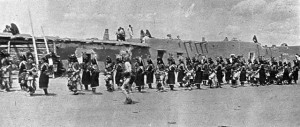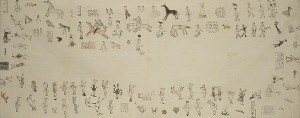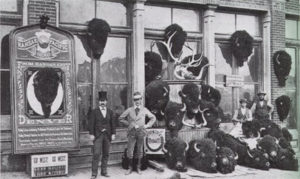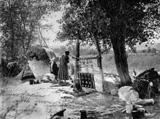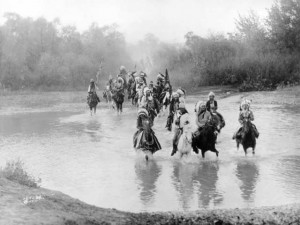The controversy over Native American dancing did not arise all at once, of course (see last post). European settlers were often surprised at the energy and freedom inherent in many ceremonial dances, but unfortunately attributed much of it to the “uncivilized” status of Native Americans. Continue reading
Tag Archives: Plains Indians
Lakota Winter Counts
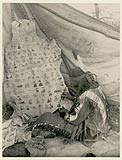
Sam Kills Two, Lakota Winter Count Keeper, circa late 1800s, courtesy National Anthropological Archives
Winter was an important time of year for Native Americans, partly because it allowed time for reflection, repair, and planning. Plains Indians documented their year through “winter counts,” which were pictorial histories drawn on materials like deer hides, buffalo skins, or even paper. A pictograph for the year depicted an important or memorable event for the community preserving it; yearly pictographs were arranged in a spiral or in rows. These pictographs were in chronological order, and served as memory prompts for the group’s oral historian. Individuals could also create their own winter counts so they could remember important events in their lives.
A community’s historian did not arbitrarily decide upon the most memorable event of the year, but instead, consulted with elders to decide what that year’s event would be. The event was not merely important, but also memorable–which means that it was often unique or unusual. A brilliant meteor shower, terrible sickness, great hunts, and so on, would be candidates for a winter count pictograph, rather than an important but annual event.

Lone Dog's Winter Count. Smallpox Outbreak 1801-1802, Successful Hunt 1837-1837, and Arrival of Cattle from Texas 1868-1869
______________________________________________________________________________________
Winter and Scarcity
Like many peoples dependent upon agriculture and hunting, Native Americans could face scarcity and deprivation if crops were poor or hunting was bad. If tribes had a regional primary food source, such as corn in parts of the Southwest or buffalo on the Plains, anything that tipped the balance against them had enormous ramifications. Losing good land hurt tribes dependent upon agriculture, and over-hunting hurt others more dependent on meat for winter survival. Many times, the intrusion of white settlers tipped the balance against Native American food security.
Native Americans on the Plains used almost every part of the buffalo, and its meat was critically important for survival. Originally, buffalo seemed to be limitless in number–some scientists estimate they may have numbered as high as 30 million before European settlers came to the continent–but several factors served to drive them to near extinction.:
–Native Americans were able to kill many more buffalo than they previously could, once they acquired horses and guns.
–Buffalo were forced to compete with horses and cattle, while ranchers killed many buffalo to clear land for cattle.
–Railroads required cleared land for trains, and workers killed many buffalo for food.
–Some buffalo were deliberately killed out of spite or as a policy to decimate the Plains’ best food source.
–Hunters and sport shooters slaughtered buffalo for the thrill of downing these enormous animals.
By the late 1990s, there were only two thousand or so buffalo left.

Last Buffalo Killed in N. Dakota (Jan 1907), courtesy Library of Congress Fred Hulstrand and F.A. Pazandak Photograph Collections
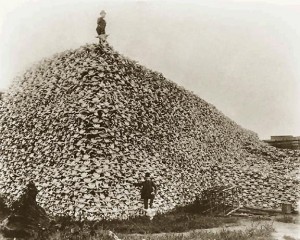
Pile of Buffalo Skulls To Be Ground Into Fertilizer, circa 1870s, courtesy Burton Historical Collection, Detroit Public Library
______________________________________________________________________________________
—
A Working Society
Like most other societies, Native Americans usually incorporated well-defined gender roles within their various groups. Men hunted, fought in battle, negotiated treaties and agreements, and made decisions about moving. Men were chiefs, medicine men, and priests, though women could also take on these roles at times.
Women raised children, farmed if the society were agricultural, tanned skins and preserved food. Though their home-making roles were similar to white women’s, Native American women typically had more power. In Cherokee society, women owned land. Plains Indians traced their lineage through their mothers. Iroquois women controlled their families and could initiate divorce, and Blackfoot women owned the tipi in which their families lived. One important difference between Native American and white societies was the respect women received for their contribution to the home.
________________________________________________________
